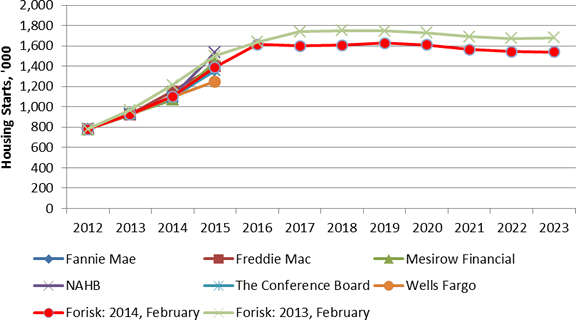Each six months, when updating our Forisk Forecast timber models, we review prior projections, and apply lessons learned from both our own work and findings from other forecasting researchers. Ben Bernanke reinforced the importance of this practice when he stepped down in January 2014 after two terms as Chairman of the Federal Reserve. In his final address as Chairman, he said, “If the experience of the past few years teaches us anything, it is that we should be cautious in our forecasts.” Amen.
Housing Starts Outlook for 2014
The literature on combining and comparing forecasts and approaches informs Forisk’s baseline assumptions for macroeconomic factors. For example, Forisk’s Housing Starts Outlook combines publicly-available, independent forecasts from professionals in the housing industry. As of February 2014, these include Fannie Mae, Freddie Mac, Mesirow Financial, the National Association of Home Builders (NAHB), The Conference Board, and Wells Fargo, as well as long-term assumptions from the Energy Information Administration’s (EIA) model of the US economy (Figure 1).
Figure 1. Forisk Forecast U.S. Housing Starts Outlook, Base Case

Our 2014 (February) Base Case peaks at 1.627 million housing starts in 2019. For comparison, our February 2013 Base Case peaked at 1.749 million housing starts in 2018. Overall, housing has slowed over the past twelve months, with projected totals for 2014 dropping 9% from 1.214 million to 1.103 million. The decline split the difference between Forisk’s 2013 “Base Case” and “Slow Case” scenarios.
Economists have varied in the extent to which they have modified their individual outlooks. Of the individual housing forecasters tracked by Forisk, Mesirow Financial made the most substantive adjustments to its outlook, dropping projected starts by 18.9% (250K) for 2014 relative to expectations as of mid-2013. Wells Fargo made the most modest adjustment, reducing projected housing starts by 3.5% (40K) relative to expectations as of mid-2013. Most of the changes have reflected adjustments in timing – the recovery is slower than expected – rather than in the potential for economic growth.
This content may not be used or reproduced in any manner whatsoever, in part or in whole, without written permission of LANDTHINK. Use of this content without permission is a violation of federal copyright law. The articles, posts, comments, opinions and information provided by LANDTHINK are for informational and research purposes only and DOES NOT substitute or coincide with the advice of an attorney, accountant, real estate broker or any other licensed real estate professional. LANDTHINK strongly advises visitors and readers to seek their own professional guidance and advice related to buying, investing in or selling real estate.










Add Comment